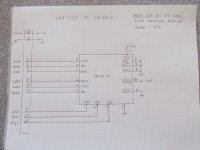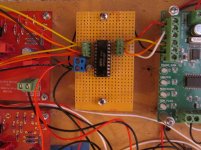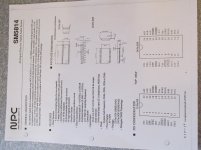Background... My cousin discovered way back in the late 1980's a better option to the Philips SAA7220 digital filter. I recently got permission from him to disclose the information for DIY use. So as my cousin has no presence here I give him full credit for the information contained in this thread. Thank you Mr. Joel Henry of Apple Valley, Minnesota.  The device in question is the NPC SM5814 4X oversampling digital filter. This chip has a special feature. It has I2S output capability. The only caveat is this filter needs 2's complement, MSB first right justified data on the input. Back in the day we used glue logic on the input to use it in Philips based CD players. This was not ideal however. Today we have another option. Most people build stand alone D/A converters. That being the case we can now cleanly apply this part with substantial gains in clarity and fidelity with the various flavors of the TDA1541, TDA1541A etc. I have 3 stand alone D/A converters built up running this digital filter. So I can say with certainty that it works and works well. Suggested configuration..... WM8804 (input receiver output set to 2's complement, MSB first, right justified data). NPC SM5814 set for I2S output. TDA1541 (Red Baron or other board). I/V, I have a preference for the no negative feedback types such as the AD844 in triple stack, Pedja Rojic's DDNF Discrete diamond no feedback I/V with buffer modification or the ADEL2020 in a standard feedback configuration. Filter preference is a second order transformer based filter using a Cinemag, Edcor or other line input transformer. I will attach the hard to find datasheet...
The device in question is the NPC SM5814 4X oversampling digital filter. This chip has a special feature. It has I2S output capability. The only caveat is this filter needs 2's complement, MSB first right justified data on the input. Back in the day we used glue logic on the input to use it in Philips based CD players. This was not ideal however. Today we have another option. Most people build stand alone D/A converters. That being the case we can now cleanly apply this part with substantial gains in clarity and fidelity with the various flavors of the TDA1541, TDA1541A etc. I have 3 stand alone D/A converters built up running this digital filter. So I can say with certainty that it works and works well. Suggested configuration..... WM8804 (input receiver output set to 2's complement, MSB first, right justified data). NPC SM5814 set for I2S output. TDA1541 (Red Baron or other board). I/V, I have a preference for the no negative feedback types such as the AD844 in triple stack, Pedja Rojic's DDNF Discrete diamond no feedback I/V with buffer modification or the ADEL2020 in a standard feedback configuration. Filter preference is a second order transformer based filter using a Cinemag, Edcor or other line input transformer. I will attach the hard to find datasheet...
NPC SM5814

Actually there are a number of chips available in warehouses in Hong Kong. Although obsolete they are quite available. I have 4 in shipment right now. So far no fakes. With this thread that may well change. PM me and I will give you a source for that chip. The datasheet appears to be to large to post. I don't have hosting anywhere so if someone wants to do it please PM me for that as well. The datasheet is pretty rare to find.thanks for your input on this DF, but it seems a very hard to find one, haven't seen it anywhere available
ADEL2020

It is the best feedback type I/V chip I have tried. I have not compared it with the OPA861. Now that I am working with Pedja's DDNF discrete circuit I doubt I will try the OPA861. I could change my mind in the future..... as is the adel2020, even better than the newer opa861 ?
Hi,
I didn't know it was a feedbacked oap ! I believed only it was more musical than both the ad844 & opa861 but just gived up as a discontinued stuff.
I use it as well but with a ad1862 with no dc servo (Painkiller member 's design) so I have no direct benchmark with the aya2 I use both for I/V and buffer (in inverterd position)... If I understood, the BC560/550 must be matched to as well as the opa861. (I didn't match mine with the 8 I need from each reference because two mono boards, but bought it in the same time at Mouser...so hopping they have close spec because near in the production chain... maybe I dream too much !
I didn't know it was a feedbacked oap ! I believed only it was more musical than both the ad844 & opa861 but just gived up as a discontinued stuff.
I use it as well but with a ad1862 with no dc servo (Painkiller member 's design) so I have no direct benchmark with the aya2 I use both for I/V and buffer (in inverterd position)... If I understood, the BC560/550 must be matched to as well as the opa861. (I didn't match mine with the 8 I need from each reference because two mono boards, but bought it in the same time at Mouser...so hopping they have close spec because near in the production chain... maybe I dream too much !
ADEL2020

The ADEL2020 is Analog Devices improved version of the EL2020. It is still in production. I plan to experiment some more with it. The old Mark I D/A needs an I/V so likely what I will try. It is pretty much a standard feedback Video op amp. So it might be fast enough behind a current output dac. Discrete I/V's benefit from matching transistors if you want to direct couple the output. I plan to do that in the near future with the DDNF Pedja I/V with a PCM1704 converter. I just had a bunch of medical expenses so have to wait on a bench DMM pending my out of pocket expenses. The OPA861 is an interesting I/V idea. I am sure Pedja choose it for more then one reason. If you try the OPA861 I'd be interested in hearing about it.Hi,
I didn't know it was a feedbacked oap ! I believed only it was more musical than both the ad844 & opa861 but just gived up as a discontinued stuff.
I use it as well but with a ad1862 with no dc servo (Painkiller member 's design) so I have no direct benchmark with the aya2 I use both for I/V and buffer (in inverterd position)... If I understood, the BC560/550 must be matched to as well as the opa861. (I didn't match mine with the 8 I need from each reference because two mono boards, but bought it in the same time at Mouser...so hopping they have close spec because near in the production chain... maybe I dream too much !
Yes, it will. But it does not have the upsampling/filter capability the SAA7220 has. One would need an extra CS8421 to accomplish the same functionality.Will the WM8804 not drive the TDA1541 directly?
Less processing, No Digital Filtering, Less Component Count......=Better Sound (?).
Just a thought.
I drive a TDA1541 with a WM8805, directly. Very, very nice.
P.
no one has emulated this in a Rasberry ? http://vasiltech.narod.ru/files/PMD100.pdf
PMD100
 Nice if someone would emulate the PMD100....
Nice if someone would emulate the PMD100....
That would be an excellent digital filter however go price one. The NPC SM5814 is cheap. It features more taps and best of all it is doing 18 bit math. SAA7220 is 14 bit math. Sound difference is large. Better clarity and the trebles are awesome with the NPC chip. Something no NOS D/A in my experience can do.no one has emulated this in a Rasberry ? http://vasiltech.narod.ru/files/PMD100.pdf
 Nice if someone would emulate the PMD100....
Nice if someone would emulate the PMD100....Is there any jitter measurement of this chip ?
Problem with such a chip is like the Philips it's more Noisy or have more jitter than the dac chip itself ?
Because with the modern front end which have very low jitter level you may waste the whole result by introducing such a chip between the front end and the final dac chip.
But if it sound good at ears, it's also a good sign ...
...
Problem with such a chip is like the Philips it's more Noisy or have more jitter than the dac chip itself ?
Because with the modern front end which have very low jitter level you may waste the whole result by introducing such a chip between the front end and the final dac chip.
But if it sound good at ears, it's also a good sign
NPC SM5814
I have never seen any jitter testing and don't have that equipment available. The chip came out in the late 1980's and didn't get much attention. In that time most of the datasheets didn't even make it to the internet such as it was. My cousin got his datasheet from a distributor that was selling it. The better the input receiver the better the results. So it works great with the DIR9001 however even better with the WM8804. So for me what sets it apart is the quality of the treble. Crystal clear with such detail. This assumes a very good I/V and downstream circuitry. My Mark II D/A I consider reference quality. It took years to get it there.Is there any jitter measurement of this chip ?
Problem with such a chip is like the Philips it's more Noisy or have more jitter than the dac chip itself ?
Because with the modern front end which have very low jitter level you may waste the whole result by introducing such a chip between the front end and the final dac chip.
But if it sound good at ears, it's also a good sign...
Datasheet

I tried to attach it and it was to large. PM me with an email and I will send it to you. See my response to Eldam why it can't be found on the internet.@Torchwood421: are there other digital filters with better availability than the NPC SM5814, eg. the SM5840?
I searched for it on the internet, but was not able to even find the datasheet.

SM5840

SM5840 is 2's complement, MSB first, right justified both input and output. So not really easy to use. You need I2S output....@Torchwood421: are there other digital filters with better availability than the NPC SM5814, eg. the SM5840?
I searched for it on the internet, but was not able to even find the datasheet.
- Home
- Source & Line
- Digital Line Level
- Alternative to the SAA7220 for TDA1541 dac's


